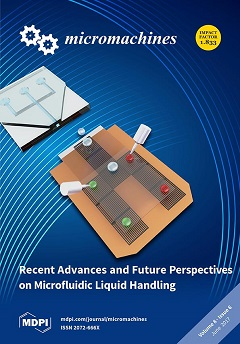Artificial photosynthesis is the imitation of natural photosynthesis, which promises an efficient way to use solar energy to synthesize organic matters, in which the key step is the coenzyme regeneration (NADH/NADPH). To achieve an efficient regeneration rate, various photocatalysts have been developed, such
[...] Read more.
Artificial photosynthesis is the imitation of natural photosynthesis, which promises an efficient way to use solar energy to synthesize organic matters, in which the key step is the coenzyme regeneration (NADH/NADPH). To achieve an efficient regeneration rate, various photocatalysts have been developed, such as g-C
3N
4 and mesoporous carbon nitride (mpg-C
3N
4). Generally, efficiency determination of different photocatalysts requires laborious experiments, high consumption of reagents, and a considerable amount of time. Here, based on the one-step artificial photosystem I method, we processed the analytical experiment in a very simple PDMS well (20 μL, a drop) to achieve a rapid screening of photocatalysts. For comparison, we used two types of graphitic carbon nitrides, few-layer g-C
3N
4 and mpg-C
3N
4. Compared with the slurry systems, firstly, the regeneration rate of mpg-C
3N
4 drop-reactor system is 4.3 times and 7.1 times those of the few-layer g-C
3N
4-slurry system and mpg-C
3N
4-slurry system, respectively. Secondly, this one-drop method reduces the typical verification time from 90 min to 5 min and lowers the liquid volume from 20 mL to 20 μL. Thirdly, this operation is a pump-free and soft lithography technique-free process. The miniaturization of the photocatalytic reaction in the PDMS well improves the regeneration rates, saves samples, and achieves high-throughput screening of multiple photocatalysts.
Full article






